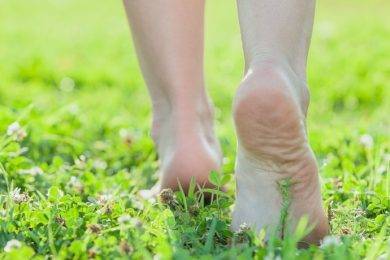We all know that spending quality time in nature is good for our health. But when was the last time you walked barefoot on any natural surface like grass, sand, or even mud? This practice of walking barefoot is also known as earthing or grounding. Read on to learn about the various benefits of walking barefoot, the risks involved, and the correct way to do it.
1. Can reduce pain and inflammation
Studies show that when your body connects to the earth, it enables free electrons from the earth’s surface to spread over the body and produce antioxidant effects. Grounding reduces pain and alters the number of circulating neutrophils and lymphocytes and affects other circulating chemical factors related to inflammation (1). So, walking barefoot can help reduce inflammation and pain.
2. Improves sleep
Earthing can help you to relax, and this improves sleep. According to research published in the Journal of Alternative and Complementary Medicine, grounding the human body to earth during sleep reduces night-time levels of cortisol. It resynchronizes the secretion of cortisol hormone more in alignment with the natural 24-hour circadian rhythm profile (2). This shows that grounding can improve sleep and reduce pain.
Another study showed that earthing the human body influences the human psychological process, which helps in night time relaxation (3). You can also take help of several web based sleep calculator to check best time to sleep.
3. Improves heart health
According to a 2013 study, direct physical contact of the human body with the earth’s surface helps reduce various cardiological risk factors. The study results showed that grounding increases the surface charge on RBCs and reduces blood viscosity and clumping (4). Grounding increases the surface charge on RBCs and thereby reduces blood viscosity and clumping.
4. Boosts immunity
Walking barefoot can also help to boost your immunity. During one study, eight healthy men in their 20s were asked to perform toe raises while carrying a barbell equal to 1/3 of their weight. Half of these men were then grounded or sham grounded with a conductive patch to the sole of their feet. The results showed that the ungrounded men showed a sharp increase in their white blood cell count while the men that were grounded showed only a slight increase in white blood cell count and recovery in the DOMS phase (5). These results indicate that grounding the body to earth can improve immune system activity.
5. Lowers anxiety and stress
Walking out in nature can help to ease your tension and lower your stress. In addition to this, barefoot contact of our feet with the earth also helps reduce our stress levels. The earth’s surface has a negative charge. It generates electrons that can neutralize free radicals by acting as antioxidants.
6. Improves posture
Walking barefoot strengthens the muscles in the feet, and this, in turn, improves stability, balance, and posture. Wearing shoes weakens the muscles in the feet. Our week feet can lead to bad posture, which further causes a back, neck, and knee pain. A new study in the British Journal of Sports Medicine demonstrates the importance of using the small stabilizing muscles of the feet with the help of barefoot walking(6).
7. Improves eyesight
According to reflexology, applying the appropriate pressure on certain parts of feet and hands can help to energize and rejuvenate other body parts (7). The pressure points on our feet are connected to the nerves in your eyes, according to reflexology. Walking barefoot stimulates these pressure points and improves our eyesight.
8. Reduces menstrual cramp pain
Walking barefoot is known to reduce pain in general, so it is even beneficial in reducing menstrual cramps. Walking barefoot reduces stress and relaxes the mind, which also helps you to relax and reduce menstrual pain.
9. Makes your senses stronger
We are often disconnected from nature and our surroundings. However, when we walk barefoot, it animates and stimulates our senses. We become alert and aware of where we are walking when we walk barefoot. Barefoot walking also helps to improve your energy levels.
Dangers of walking barefoot
While there are many benefits of walking barefoot, it is not always wise to walk barefoot in public places. If you are used to walking while wearing shoes and have just started walking barefoot, it may be wise to walk around in your yard. Here are some of the risks of walking barefoot:
1. Injury from hot surfaces
The soles of your feet are highly sensitive. If you walk on a hot sidewalk or even on hot sand on the beach, you can injure your feet. You may develop burns and blisters.
2. Injury from sharp objects
Walking on the grass in your yard is safe, but it is not wise to walk barefoot in public areas. These areas may be littered with glass, metal objects, and nails, which can injure your foot.
3. Foot infections
Walking barefoot in public places can make you susceptible to fungal and bacterial infections. These harmful organisms can enter your foot through tiny cracks or cuts in your feet and cause infections. Avoid walking barefoot in public places like restrooms, public showers, gyms, and poolside dressing rooms.
4. People with diabetes should be more careful
People with diabetes should never walk barefoot. People with diabetes are prone to developing a condition called peripheral neuropathy over time. This condition causes loss of sensation in the extremities. So you may not even notice if you develop an infection or an injury in your foot. It is also more difficult for a person with diabetes to get rid of the infection once they develop it.
The right way to walk barefoot
1. Ease into it
Don’t try too much too quickly. Start with just ten to 15 minutes of walking barefoot. Let your foot muscles get used to the new way of walking. They have been used to the support of shoes for such a long time; they need some time to adjust.
2. Walk indoors first
Before you decide to walk on the sidewalk or the park, you must first begin by walking at home. This process will help you get used to the idea.
3. Practice on safe surfaces
Find surfaces that are clean and comfortable to walk on. Many parks have paths designed for walking on different surfaces. These are known as barefoot reflexology paths.
4. Try simple foot exercises
Simple balancing exercises can help to strengthen the muscles of your feet. Curl your toes, or lift your heels, and let them drop, or balance yourself on one foot.
5. Do activities that need you to be barefoot
Activities like yoga, Pilates, and martial arts require you to be barefoot. Doing these activities can get you more comfortable with the idea of walking barefoot.
6. Examine your feet
You must examine your feet for injuries regularly.
Final thoughts
Walking barefoot is a great way to connect with nature and enjoy its health benefits. Walking without shoes improves your gait and posture and strengthens your feet. When your body connects with the earth, it can help reduce stress, pain, and inflammation, boosts immunity, improve heart health, and improve eyesight.
While walking barefoot is beneficial, it can also lead to injuries and infections. People with diabetes should avoid walking barefoot. Start slowly and gradually increase the time that you spend barefoot. Practice on safe surfaces and exercise your feet to strengthen the muscles.
For Nicole Ann Pore, as cliche as it sounds, there is no place like home. She believes that is not only a responsibility but also a privilege to create and take care of a house where home is built. Nicole writes on topics that reveal the essence of a nice home, as well as home care and improvement tips. She is a daytime writer for Wincrest Bespoke, one of New South Wales’ most experienced home residential builders. | Nicole graduated Cum Laude from De La Salle University Manila, Philippines with a Bachelor’s Degree in Communication Arts.











